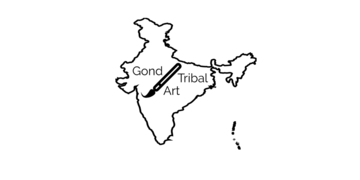Gond Art
Origins
The Gond community is one of the largest remaining indigenous tribes or Adivasis in India. The word Gond itself originates from the Dravidian expression “kond”, meaning “the green mountain”. Located in Madhya Pradesh and its surrounding states, their paintings contain a mixture of folk and tribal elements, making them extremely unique. The first recorded Gond paintings began around 1,400 years ago. However, considering they inhabited areas around which rock paintings going back to the Mesolithic age have been found, it is entirely possible that they date back even further. The Gond tribe began decorating their walls with traditional tattoos and motifs, following the belief that viewing a good image begets good luck. The Pardhan (or clergy) are a sect of Gonds who are priests and storytellers. They are the minstrels, bards, genealogists and honorific story-tellers of the community. The stories that the Gonds held dear to them were passed down by the Pardhans through generations, set to song and accompanied by music from the stringed instrument call the “bana”. Gond art is an embodiment of these songs into images of good fortune.
Inspirations
Gond art reflects the belief that "viewing a good image begets good luck". This inherent belief led the Gonds to paint traditional tattoos and motifs on the walls and floors of their homes, following their cave-dwelling forebears. Gond art, in its original form, was intended to be an offering in the worship of nature. According to Gond mythology, each and everything in nature, whether it be a hill, river, rock or a tree, is guarded by a spirit and, consequently, is sacred. Their art forms are often a way of pleasing the deities and are a demonstration of Man’s symbiotic relationship with nature. Thus, the majority of Gond paintings are inspired by nature and contain depictions of local flora, fauna and Gods such as Marahi Devi and Phulvari Devi (Goddess Kali). Medi Ki Mata (the protector of the grains), Mashwasi Devi and even Raksa (the Gond demon God) find representation in Gond paintings. The most revered deities are Bada Dev (the biggest of the Gods), responsible for the creation of the world and Thakur Dev. Bada Dev is symbolized using a Saja (or Shaja) tree and Thakur Dev is associated with the pakri tree. Trees consequently find a special place in the Gond paintings Gond paintings also portray abstract concepts like dreams, emotions and imagination. Their art work is rich in detail, colour, mystery and even humour. Gond tribal art is an artistic exploration of our reverence and connection to nature. All natural objects are sacred in the eyes of a Gond artist, and intimately connected to nature. The unique oral narrative tradition of the Gonds is reflected in their paintings as well. The work of Gond artists is rooted in their folk tales and culture, and every painting has an engaging back-story. Every artist has a distinctive style and has developed a specific language within these narratives, creating a richness of aesthetic forms and styles.
Creating Gond Art
In the early 1980s, the renowned modern artist Jagdish Swaminathan, in his capacity of Director of the Bharat Bhavan, was scouting talented artists to display their works in the ambitious art centre. He discovered an extremely talented seventeen-year-old boy painting the walls of his hut in Patangarh, Madhya Pradesh with beautiful traditional Gond ceremonial imagery. The boy, Jangarh Singh Shyam, was forced into manual labour at a young age to support his family despite his obvious inclination towards the arts. Swaminathan persuaded Jangarh to move to Bhopal and pursue a career as a professional artist. and encouraged him to experiment with paints on paper and canvas. Jangarh quickly became a renowned artist, with his work featured in esteemed exhibitions around the globe. He experimented and improvised, painting on paper and canvas and using vibrant acrylic colours and sophisticated implements such as point-pens and markers. Following his tragic suicide in 2001 at the tender age of 39 years, he left behind a legacy which inspired many more artists to take up painting. Some art historians refer to the school of expression as “Jangarh Kalam” (or “Style of Jangarh”) since Gond art did not exist before he burst into public consciousness. Many Gond artists use natural paints made from charcoal, coloured soil, plant sap, rice paste and even cow dung. The paintings feature vivid colours such as blue, red, yellow and white. Each artist has created their own distinct style through the use of signature patterns to infill the larger forms on the canvas. This form of art is characterised by a series of carefully drawn lines, dots and dashes, which conveys a sense of movement to the still images. There is a sense of balance and symmetry in the patterns used, which highlight the Gond artist’s skill and creativity. The original canvas for Gond paintings was the walls and floors of their homes. The Gonds continue this practice to date, painting their walls at the time of religious rituals, festivals and celebrations (such as Karwa Chauth, Diwali, Ashtami and Nag Panchmi). The paintings typically depict these celebrations and rituals. These days Gond artists have switched to using poster colours and canvases, which makes the paintings even more colourful. Modern Gond paintings on wood, trays and boxes are becoming increasingly popular as well. Fortunately, Gond artists have gained recognition with art galleries around the world including their work. The Indian government is also endeavouring to preserve its heritage and culture. The artwork is sometimes referred to as “painted stories” due to its strong association with storytelling and folklore. Every single painting is markedly different and tells its own story.
